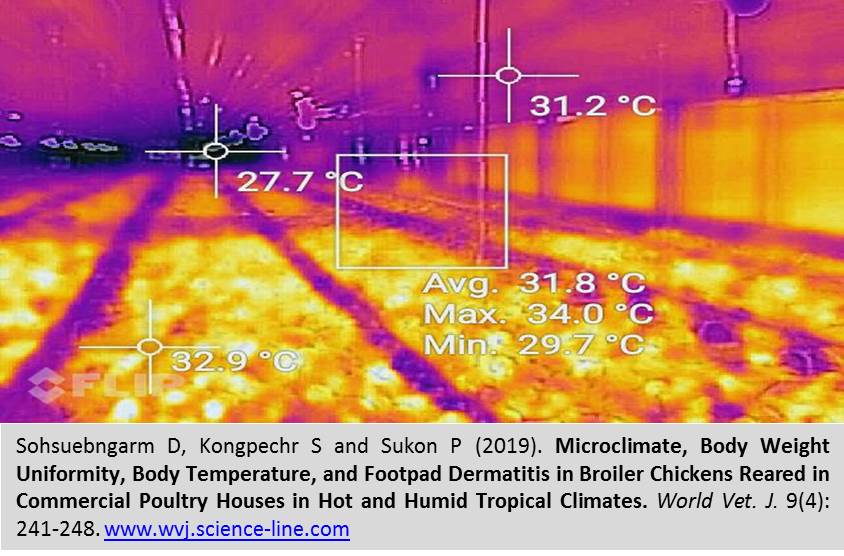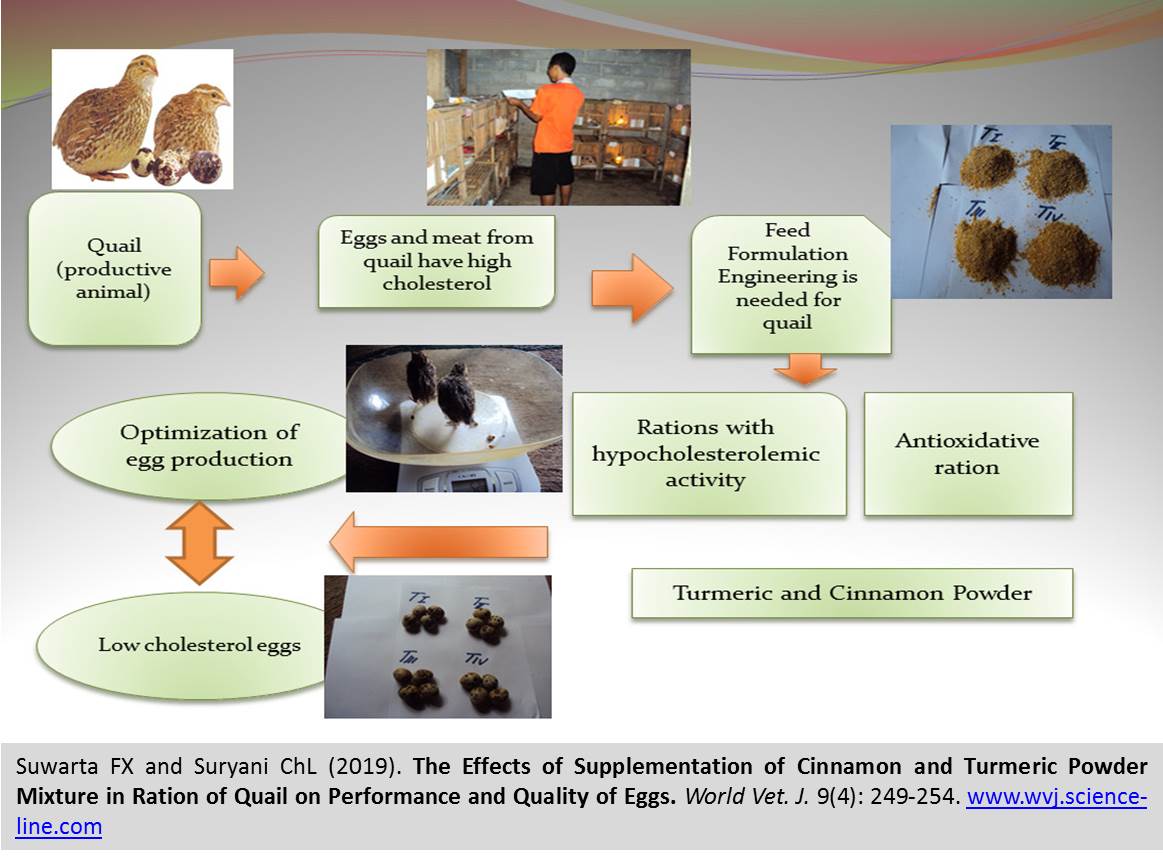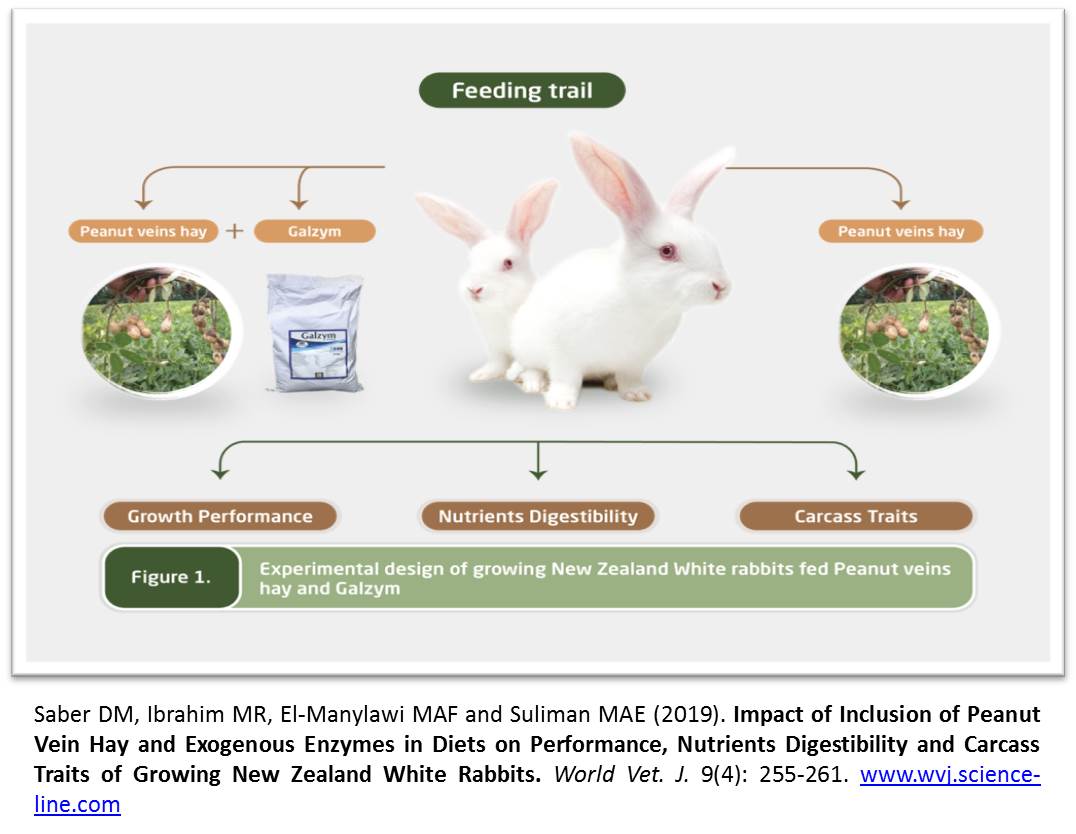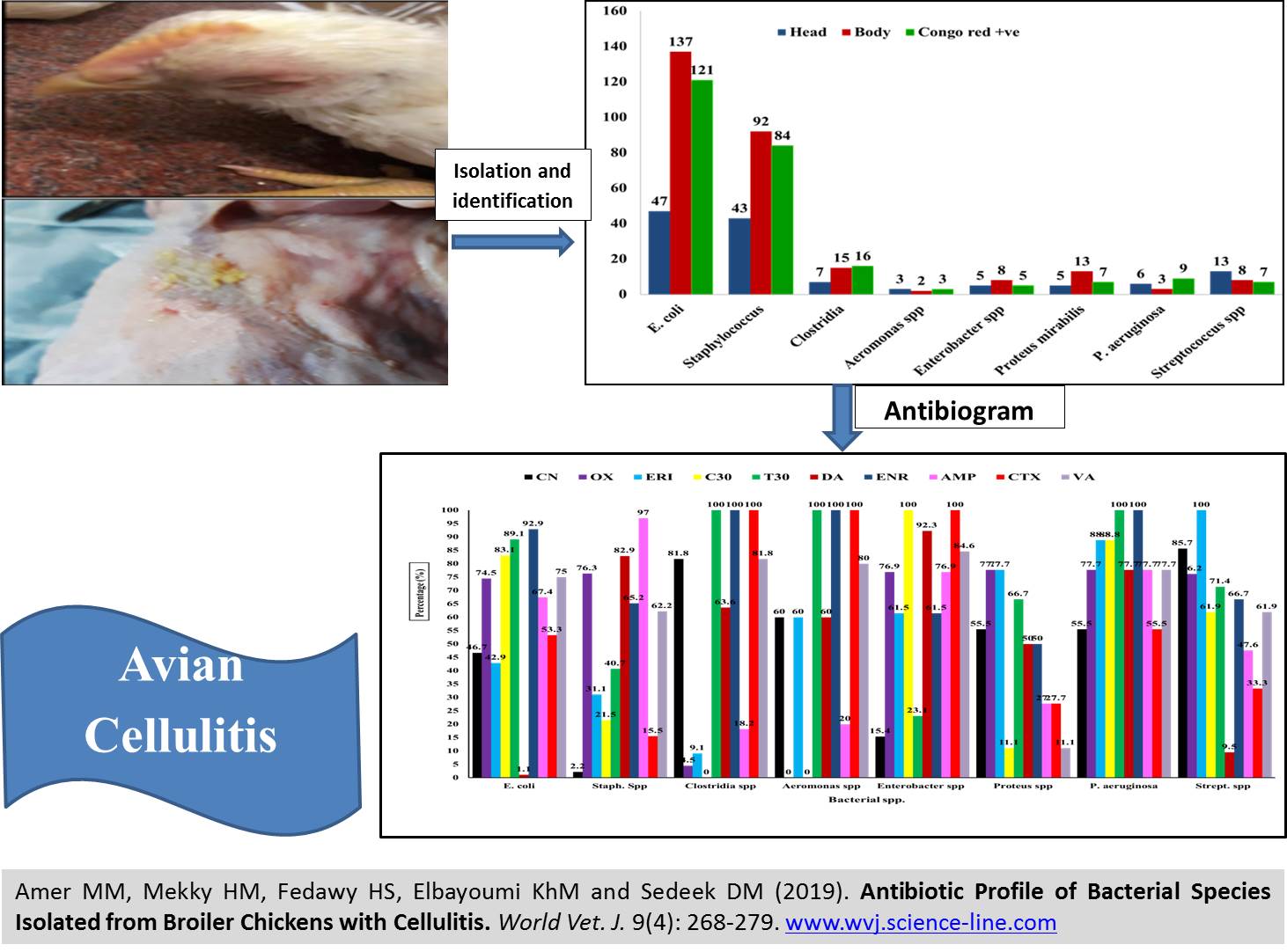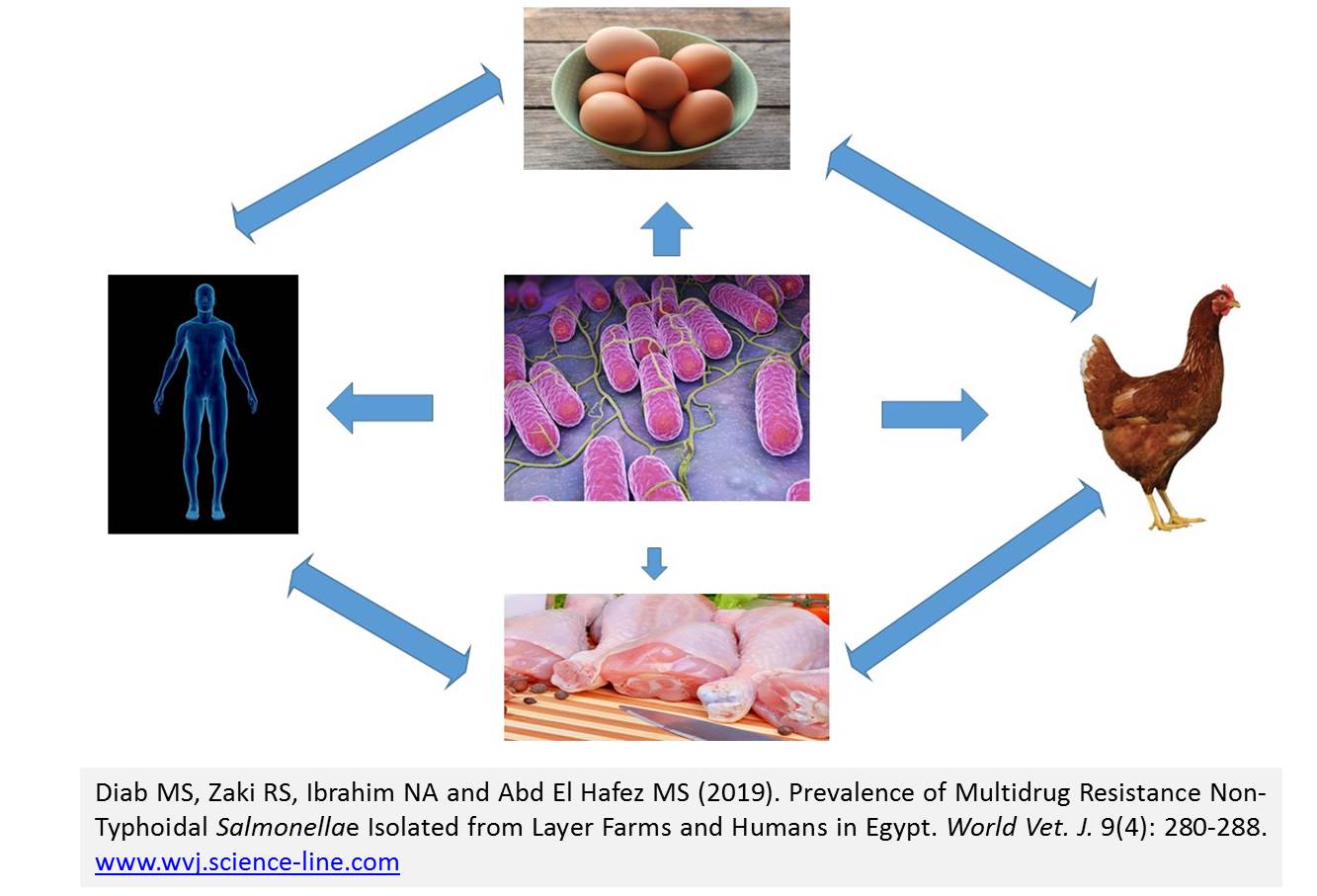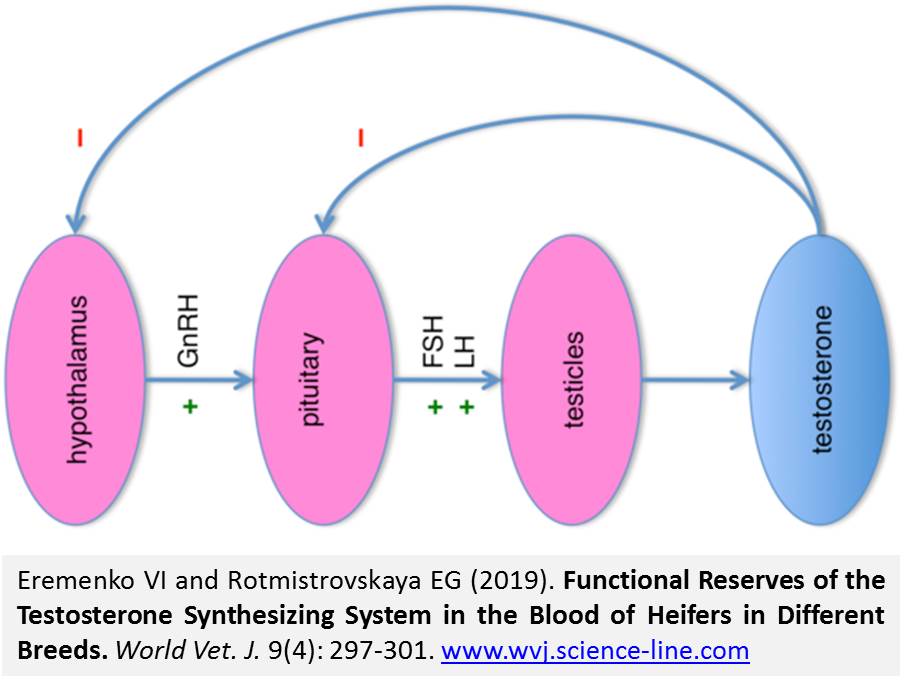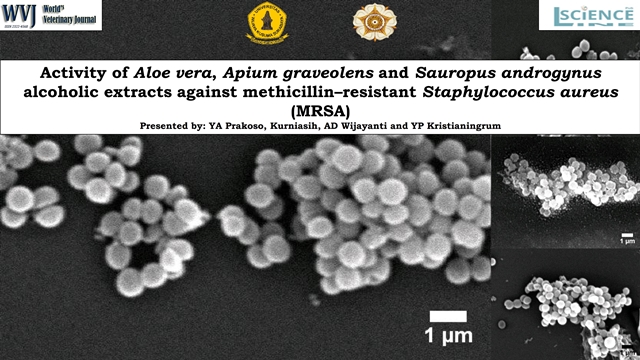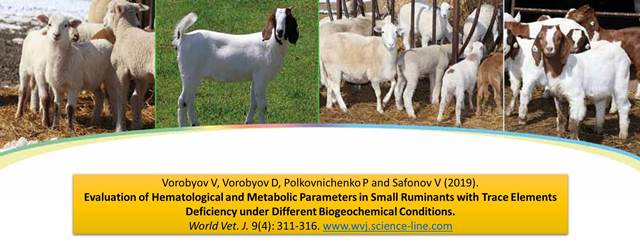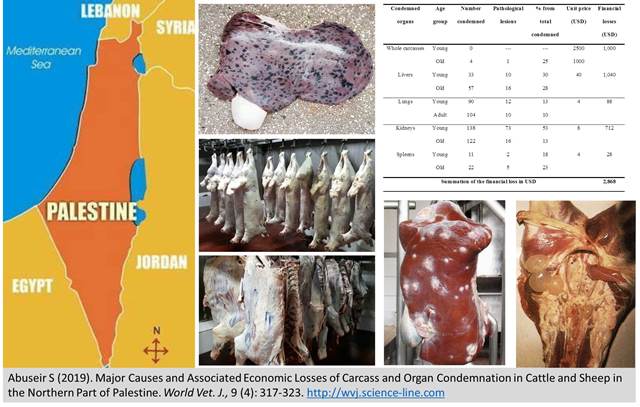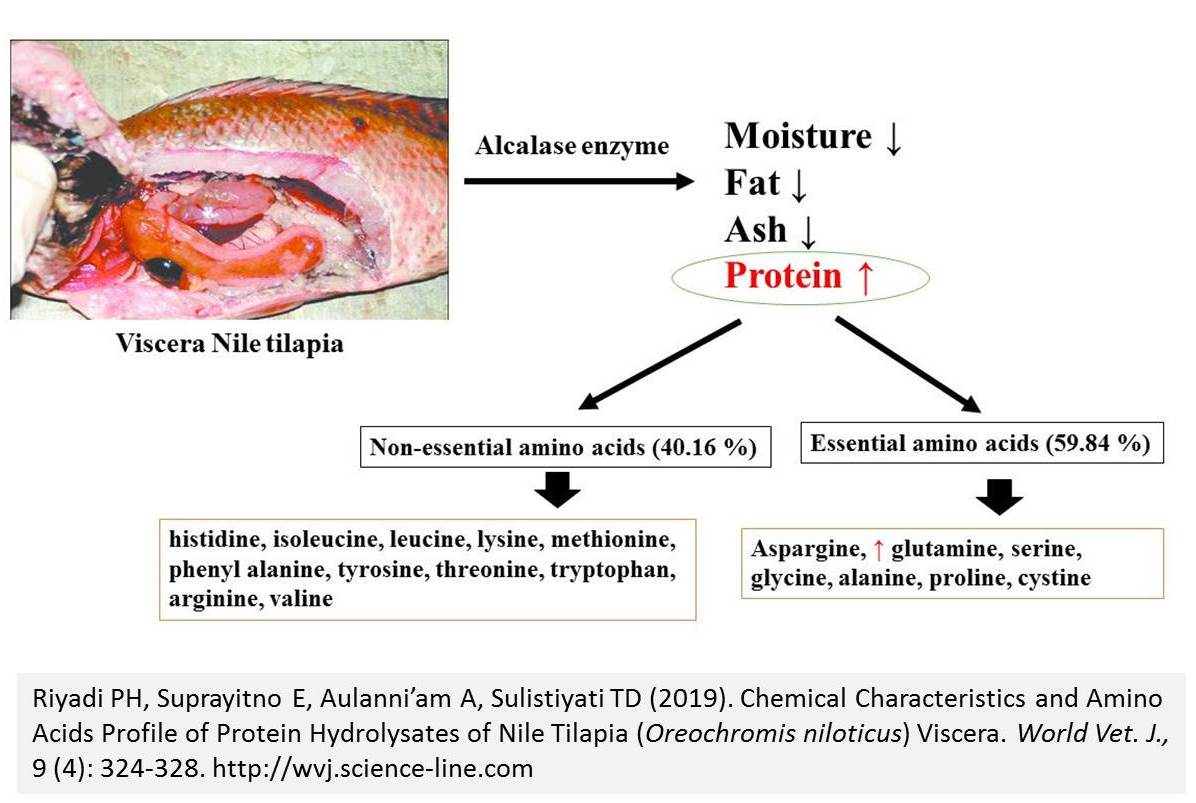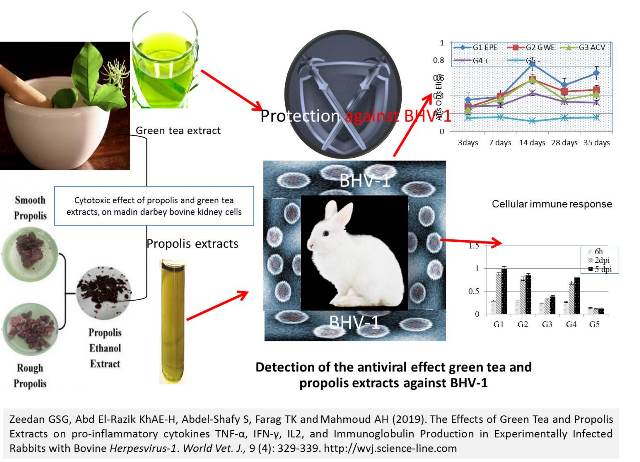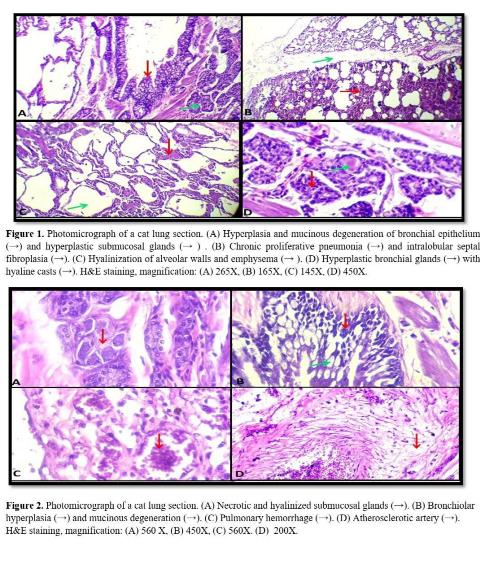Previous issue | Next issue | Archive
![]() Volume 9 (4); December 25, 2019 [Booklet] [EndNote XML for Agris]
Volume 9 (4); December 25, 2019 [Booklet] [EndNote XML for Agris]
Microclimate, Body Weight Uniformity, Body Temperature, and Footpad Dermatitis in Broiler Chickens Reared in Commercial Poultry Houses in Hot and Humid Tropical Climates.
Sohsuebngarm D, Kongpechr S and Sukon P.
World Vet. J. 9(4): 241-248, 2019; pii:S232245681900030-9
DOI: https://dx.doi.org/10.36380/scil.2019.wvj30
ABSTRACT: The present study was conducted to investigate the variations of microclimate variables along the length of commercial broiler houses and to determine the associations between microclimate variables and animal variables in broiler chickens. A routine rearing program involving 480,000 broiler chickens was conducted in 24 commercial broiler houses (with dimensions of 14×120×2.5 m, yielding 1,680 m2 of rearing area per house). Of these, 6,000 chickens were randomly selected for outcome measurements. Microclimate variables (Ambient Temperature (AT), Relative Humidity (RH), Air Velocity (AV), heat index, effective temperature, and ammonia) and animal variables (body weight uniformity, body temperature, and Footpad Dermatitis (FPD)) were measured at 10 sections (12 m apart) from the proximal end to distal end along the length of each broiler house. Regression analysis was used to determine the pattern of each microclimate variable along the length of the broiler houses and to determine the associations between the microclimate variables and the animal variables. The results showed that AT, heat index, and ammonia linearly increased from the front end to the rear end of the houses. In contrast, RH linearly decreased from the front end to the rear end of the houses. The regression analysis revealed no significant association between any of the microclimate variables and the body weight uniformity. Increasing AT and AV were associated with increasing mean body temperature. Increasing AT was associated with decreasing FPD. However, increasing RH and AV were associated with increasing FPD. In conclusion, the microclimate variables had various trends along the length of broiler houses.
Key words: Body weight uniformity, Broiler house, Footpad dermatitis, Microclimate
[Full text-PDF] [XML] [Google Scholar] [Crossref Metadata]
The Effects of Supplementation of Cinnamon and Turmeric Powder Mixture in Ration of Quail on Performance and Quality of Eggs.
Suwarta FX and Suryani ChL.
World Vet. J. 9(4): 249-254, 2019; pii:S232245681900031-9
DOI: https://dx.doi.org/10.36380/scil.2019.wvj31
ABSTRACT: The use of herbal ingredients to improve poultry production is increasingly developing in Indonesia. This study aimed to determine the effect of mixed supplementation of turmeric powder and cinnamon on the performance and egg quality of Japanese quail. This study consisted of four treatments with three replications (25 quails per replicate) established in a completely randomized design. The treatments consisted of: T0 (control); T1 (10 g turmeric + 10 g cinnamon) / kg of feed; T2 (20 g turmeric + 20 g cinnamon) / kg of feed; and T3 (40 g turmeric + 40 g cinnamon) / kg of feed. Parameters measured included feed intake, body weight, feed conversion ratio, egg production, egg weight, yolk weight, yolk color index, egg white weight, eggshell weight, and egg cholesterol level. In addition, the percentage of quails reached maturity at 42 days of age were recorded. The obtained results indicated supplementation of the mixture of turmeric and cinnamon decreased feed intake and significantly improved feed conversion ratio. Quail weight at 42 days was not significantly different in different treatments. The percentage of laying quails increased in experimental treatments. Dietary supplementation with the mixture of turmeric and cinnamon significantly increased egg production, egg weight, yolk weight, yolk color index and eggshell weight. Supplementation of turmeric and cinnamon mixture significantly reduced low-density lipoprotein levels and increased high-density lipoprotein in egg yolk. It is concluded that the dietary inclusion of turmeric and cinnamon powder mixture (40 g + 40 g) / kg of feed can improve the performance and egg quality of quails.
Key words: Cinnamon powder, Egg quality, Performance, Quail, Turmeric powder
[Full text-PDF] [XML] [Google Scholar] [Crossref Metadata]
Research Paper
Impact of Inclusion of Peanut Vein Hay and Exogenous Enzymes in Diets on Performance, Nutrients Digestibility and Carcass Traits of Growing New Zealand White Rabbits.
Saber DM, Ibrahim MR, El-Manylawi MAF and Suliman MAE.
World Vet. J. 9(4): 255-261, 2019; pii:S232245681900032-9
DOI: https://dx.doi.org/10.36380/scil.2019.wvj32
ABSTRACT: The present study examined the effect of replacing clover hay with Peanut Vein Hay (PVH) and Galzym (multi-enzyme) additive on growth performance and carcass traits of rabbits as well as nutritive value and economic efficiency of diets. Seventy-two growing New Zealand White rabbits aged about 6 weeks divided into six experimental treatments (12 rabbits per treatment). The experimental treatments were T1, control diet without Galzym; T2, control diet with Galzym; T3, 25% PVH without Galzym; T4, 25% PVH with Galzym; T5, 50% PVH without Galzym and T6, 50% PVH with Galzym. The obtained results revealed that final body weight and body weight gain significantly increased in T3 and T4 compared to T1. Rabbits on T3 consumed a higher amount of feed compared to the other groups. There were no significant differences in feed conversion ratio and carcass traits among the experimental groups. The increase in the substitution level of PVH had a significant effect on growth performance except the FCR was not significantly different. While adding Galzym to rabbit diets had no effect on growth performance. The experimental diets and substitution levels of PVH significantly affected total digestible nutrients and digestible energy. In conclusion, feeding growing rabbits with 25% PVH, with or without Galzym, leads to better growth performance and higher economic efficiency without any adverse effect on rabbit health.
Key words: Carcass, Enzyme, Feed intake, Rabbits
[Full text-PDF] [XML] [Google Scholar] [Crossref Metadata]
Experimental Model of Coccidiosis Caused by Eimeria Tenella in Broiler Chickens.
Safiullin RT, Kachanova EO, Chalysheva EI and Andreyanov ON.
World Vet. J. 9(4): 262-267, 2019; pii:S232245681900033-9
DOI: https://dx.doi.org/10.36380/scil.2019.wvj33
ABSTRACT: Coccidiosis is the most common protozoan disease in poultry and is often recorded in poultry farms with the free-range system. The share of such poultry farms is constantly growing in Russia. The present study designed an experimental model of coccidiosis induced by Eimeria tenella in broilers. Forty-two 14-days-old broilers of the cross "ABH 47" were divided into seven groups of six broilers each according to the principle of analogs. Broilers were weighed at the beginning and at the end of the experiment. The groups were kept isolated throughout the study. Chickens in groups 1, 2, 3, 4, 5 and 6 were orally infected with E. tenella culture at the doses of 2,000; 1,000; 250; 125; 62 and 15 oocysts/ml, respectively. Broilers of group 7 were uninfected and served as control. To determine the number of oocysts, all feces from the broilers of each experimental group were daily collected from the days 6 to 12 after infection. Counting was carried out using the McMaster technique. The average number of E. tenella oocysts per gram of feces in broilers of the groups 1 to 6 was 4,080; 6,880; 1,780; 1,530; 662 and 94, respectively. The average daily weight gain in groups 1 to 4 was significantly lower compared to the non-infected control group. The experimental model of coccidiosis in broiler chickens revealed that the number of oocysts excreted with feces is dependent on the dose of infection.
Key words: Broilers, Eimeria tenella, Experimental model, Oocysts
[Full text-PDF] [XML] [Google Scholar] [Crossref Metadata]
Antibiotic Profile of Bacterial Species Isolated from Broiler Chickens with Cellulitis.
Amer MM, Mekky HM, Fedawy HS, Elbayoumi KhM and Sedeek DM.
World Vet. J. 9(4): 268-279, 2019; pii:S232245681900034-9
DOI: https://dx.doi.org/10.36380/scil.2019.wvj34
ABSTRACT: HeaThe present study was carried out to isolate and identify the bacterial agents involved in field cases of avian cellulitis in broiler chickens and also to examine isolated bacteria for antibiotic susceptibility. The study was applied on 290 broiler chickens, aged 30-35 days, suffered from cellulitis (65 with head and 225 body lesions) to isolate bacterial agents. All obtained isolates were identified and tested for the pathogenicity based on Congo red assay. Disc diffusion test was used to study the sensitivity pattern of bacterial isolates with determination of multiple antibiotic resistance index. Results revealed that all head and 91.5% of body samples were positive on bacteriological examination. E. coli was the most prevalent isolate (45.2%), followed by staphylococci (33.2%), Clostridia (5.4%), streptococci (5.1%), Proteus mirabilis (4.4%), Enterobacter spp. (3.2%), Pseudomonas aeruginosa (2.2%), and Aeromonas spp. (1.2%). Congo red binding test was positive for P. aeruginosa (100%), Clostridia (72.7%), E. coli (65.8%), staphylococci (62.2%), Aeromonas spp. (60%), P. mirabilis (38.9%), Enterobacter spp. (38.5%) and streptococci (33.3%). Serological typing of E. coli identified nine O serotypes, with high predominance of O78 (19%). On antibiotic susceptibility profiling, E. coli isolates demonstrated 83.1-92.9% resistance to chloramphenicol, tetracycline, and enrofloxacin. Staphylococci isolates showed high resistance to ampicillin (97.0%) and clindamycin (82.9%). Clostridial and Aeromonas spp. isolates showed 100% resistant to tetracycline, enrofloxacin, and cefotaxime. Enterobacter spp. showed 100% resistance to chloramphenicol and cefotaxime. P. aeruginosa had 100% resistance to tetracycline and enrofloxacin. Also, streptococci isolates showed 100% resistance to erythromycin. Totally, 56.3% bacterial isolates were multidrug-resistant, 23.8% extensively drug-resistant and 1.5% pan drug-resistant. The present study concluded that E. coli is the most predominant pathogen involved in cellulitis, particularly O78 serotype. In addition, this study demonstrated high prevalence of multidrug-resistant bacteria among isolates, particularly against commonly used antibiotics. Therefore, it is recommended to use antibiotic sensitivity tests and accurate therapeutic doses to efficiently treat and control bacterial infections in poultry.
Key words: Antibacterial susceptibility, Bacterial isolates, Broiler, Cellulitis, Sensitivity classes.
[Full text-PDF] [XML] [Google Scholar] [Crossref Metadata]
Prevalence of Multidrug Resistance Non-Typhoidal Salmonellae Isolated from Layer Farms and Humans in Egypt.
Diab MS, Zaki RS, Ibrahim NA and Abd El Hafez MS.
World Vet. J. 9(4): 280-288, 2019; pii:S232245681900035-9
DOI: https://dx.doi.org/10.36380/scil.2019.wvj35
ABSTRACT: Non-Typhoidal Salmonella (NTS) are substantial foodborne pathogens that lead to bacteremia, gastroenteritis, and focal infection. Poultry is one of the usual provenances for the development of multidrug-resistance NTS. This problem has increased in developing countries with the indiscriminate use of antibiotics in the poultry production system. The current study aimed to determine the prevalence and tendency of antimicrobial resistance of zoonotic Salmonella spp. A total of 601 samples, including cloacal samples (150) eggshell (150), egg content (15 pooled samples), layer hen carcasses (150), hand swab (68) and stool samples (68) from poultry workers, were collected from five layer chicken farms. Isolation of NTS was performed by using different cultural and biochemical methods. Moreover, Salmonella isolates were evaluated for antimicrobial susceptibility using the disc diffusion method. The cloacal samples and stool samples showed the prevalence of Salmonella spp. at approximately similar rates of 4.7% and 4.4%, respectively. Chicken isolates were identified as S. Enteritidis, S. Typhimurium, and S. Gallinarum while the human isolates were only S. Typhimurium and S. Enteritidis. The prevalence of the NTS on the surface of the eggshells (7.3%) was higher than that in the other samples. Among 12 antimicrobials tested, 86.4% resistance was found to streptomycin and oxytetracycline followed by neomycin and erythromycin (77.3%), norfloxacin and ampicillin (68.2%) across the study sites. Kanamycin and gentamicin remained sensitive by 95.5% and 90.9%, respectively. The present study indicated that layer chickens and its products are important sources for human infection with multiple-drug resistant NTS strains.
Key words: Antibiotic sensitivity, Egg, Layer poultry, Non-typhoidal Salmonella, Zoonoses
[Full text-PDF] [XML] [Google Scholar] [Crossref Metadata]
Epidemiological Study on Highly Pathogenic Avian Influenza H5N1 Virus with Modeling the Impact of Climate Variability on Outbreak Occurrence in Some Governorates of Nile Delta, Egypt.
Elsobky Y, Byomi A, El Afandi G, Aly M, Zidan Sh and Hadad Gh.
World Vet. J. 9(4): 289-296, 2019; pii:S232245681900036-9
DOI: https://dx.doi.org/10.36380/scil.2019.wvj36
ABSTRACT: Highly Pathogenic Avian Influenza (HPAI) H5N1 virus is widely circulated between poultry flocks in Egypt. The present study described the spatiotemporal dynamics of HPAI H5N1 in five Nile Delta governorates, Egypt (Dakhlia, Qalyobia, Sharkia, Gharbia, and Menofia) where most cases were reported for the years 2006 to 2016. Moreover, this study explored the impact of climate variability in outbreaks occurrence using the statistical generalized estimating equation model. The highest prevalence rate was recorded in Dakhlia and Qalyobia governorates, while Menofia governorate had the lowest one. From 2006 to 2009, the classic clade 2.2.1 was predominant and remained stable. It was demonstrated that new unreported clades had been evolved from classic clades after the vaccination pressure until 2010 resulted in raising the PR sharply. The stability of PR from 2012 to 2014 could be attributed to the adaptation of 2.2.1.2 endemic clade. The generalized estimating equation model revealed that a one-unit increase in maximum and minimum temperature decreased the risk of a poultry outbreak by about 6% and 4%, respectively. According to the obtained results, it seems that the virus circulates and causes infection throughout the year, indicating changes in virus epidemiology and temporal patterns.
Key words: Epidemiology, Generalized estimating equation, Highly pathogenic avian influenza (HPAI)-H5N1 virus, Nile Delta governorates.
[Full text-PDF] [XML] [Google Scholar] [Crossref Metadata]
Functional Reserves of the Testosterone Synthesizing System in the Blood of Heifers in Different Breeds.
Eremenko VI and Rotmistrovskaya EG.
World Vet. J. 9(4): 297-301, 2019; pii:S232245681900037-9
DOI: https://dx.doi.org/10.36380/scil.2019.wvj37
ABSTRACT: An The objective of this article was to investigate functional reserves of testosterone-synthesizing in the black-and-white Holstein, Simmental, Aberdeen-Angus heifers, as well as cross-bred cows (Simmental × Aberdeen-Angus). To accomplish this goal the following tasks should be done: To conduct a comparative analysis of the data obtained between the experimental groups of heifers of different breeds, to carry out the functional stress tests of the testosterone synthesizing system in experimental heifers at the age of 6 months, to calculate the activity coefficients of the testosterone synthesizing system in experimental groups of heifers at the age of 6 months. The studies were carried out on black-and-white Holstein, Simmental, and Aberdeen-Angus heifers and their crossbred heifers (Simmental × Aberdeen-Angus). In order to determine the functional reserves of the testosterone synthesizing system, chorionic gonadotropin was intramuscularly administered at 6 months of age, and the activity of the testosterone synthesizing system was determined. The results of the effects of functional stress tests on the testosterone synthesizing system of the heifers indicated that the potential reserves of the testosterone synthesizing system in the Simmental and black-and-white breeds at the age of 6 months were lower than in Aberdeen-Angus and cross-breed animals. The 6-month-old Holstein and Simmental cattle had lower testosterone level relative to the compared groups of Aberdeen-Angus breed and crossbred animals. Functional reserves of the testosterone synthesizing system in experimental heifers at the age of 6 months in the group of Aberdeen-Angus heifers and in cross-breed animals were higher than the compared group. The activity coefficients of the testosterone synthesizing system were at the lowest level in the group of black-and-white and Simmental heifers.
Key words: Black-and-white Holstein, Functional reserves, Simmental, Testosterone, Testosterone synthesizing system
[Full text-PDF] [XML] [Google Scholar] [Crossref Metadata]
Activity of Aloe vera, Apium graveolens and Sauropus androgynus Alcoholic Extracts against Methicillin–Resistant Staphylococcus aureus.
Prakoso YA, Kurniasih, Wijayanti AD and Kristianingrum YP.
World Vet. J. 9(4): 302-310, 2019; pii:S232245681900038-9
DOI: https://dx.doi.org/10.36380/scil.2019.wvj38
ABSTRACT: Staphylococcus aureus is a Gram-positive bacteria that influence human health. Staphylococcus aureus becomes a more serious problem if it is resistant to methicillin. This phenomenon is known as methicillin-resistant Staphylococcus aureus (MRSA). This study aimed to elucidate the chemical compounds, antioxidant activity and efficacy of Aloe vera (AV), Apium graveolens (AG), Sauropus androgynus (SA) extracts and its combinations against MRSA. All the herbs were extracted and determined its antioxidant constituent and 2,2-diphenyl-1-picrylhydrazyl (DPPH) scavenging activity using a standard laboratory procedure. The MRSA isolates were tested against AV, AG, SA extracts and its combinations using disc diffusion and minimum inhibitory concentration (MIC) test. Further exploration was conducted using scanning electron microscope (SEM) to analyse the MRSA membrane after the treatment with 10,000× of magnification. The data was analysed using one-way ANOVA and post hoc test. The result showed that AG extract has the highest phytochemical screening and antimicrobial effects compared to the other single extract (AV and SA), even though, it has the lowest DPPH scavenging activity. The extract combinations did not consistently increase phytochemical content, antimicrobial effect, and DPPH scavenging activity of the herb extracts. However, one mg/mL of dose of herbal extracts and its combinations could be used as the minimum dose to inhibit colonisation of MRSA in vitro. Further, SEM examination showed that 1 mg/mL of dose destructed the MRSA membrane rigidity which was proved by non-uniformity of bacterial cell architecture. This in vitro study indicated that AV, AG and SA extracts and its combinations can utilize as the therapy against MRSA.
Key words: Aloe vera, Antioxidant, Apium graveolens, Methicillin – Resistant Staphylococcus aureus, Sauropus androgynus
[Full text-PDF] [XML] [Google Scholar] [Crossref Metadata]
Evaluation of Hematological and Metabolic Parameters in Small Ruminants with Trace Elements Deficiency under Different Biogeochemical Conditions.
Vorobyov V, Vorobyov D, Polkovnichenko P and Safonov V.
World Vet. J. 9(4): 311-316, 2019; pii:S232245681900039-9
DOI: https://dx.doi.org/10.36380/scil.2019.wvj39
ABSTRACT: In the present study soil, water, pasture plants, organs and tissues of crossbred sheep of the Soviet Aksaray and Zaanen German White Improved goats were analyzed for their Selenium (Se), Iodine (I), Cobalt (Co), zinc, copper, and manganese content in the Lower Volga region. The biogeochemical situation of terrestrial ecosystems of the Lower Volga region was characterized by Se, Co, and I deficiencies in soil, water, pasture plants, and feed of crossbred sheep of the Soviet Aksaray and Zaanen German White Improved goats. The deficiency of these trace elements in small ruminants had been compensated by changes in hematological parameters include high Red Blood Cell (RBC) and White Blood Cell (WBC) and biochemical parameters. Meanwhile, the analyzed trace elements in the organs and tissues of crossbred sheep (n = 6) and Zaanen German white improved goats (n = 6) demonstrated that goats had lower amounts of Se (0.0136 ± 0.002 mg/kg), I (0.19 ± 0.01mg/kg), and Co (0619 ± 0.03 mg/kg) compared to sheep. The animals were recorded with a decrease in alkali reserve, the content of total protein and lipids, vitamins A, E, C, B12, total calcium, and inorganic phosphorus, increase in glucose, conjugated dienes and malonic di-aldehyde in the blood, and functional insufficiency of the antioxidant protection system.
Key words: Biogeochemistry, Goat, Metabolism, Micronutrient deficiency, Sheep, Trace elements deficiency.
[Full text-PDF] [XML] [Google Scholar] [Crossref Metadata]
Major Causes and Associated Economic Losses of Carcass and Organ Condemnation in Cattle and Sheep in the Northern Part of Palestine.
Abuseir S.
World Vet. J. 9(4): 317-323, 2019; pii:S232245681900040-9
DOI: https://dx.doi.org/10.36380/scil.2019.wvj40
ABSTRACT: Identifying and quantifying the causes of condemnation of carcasses and organs at the slaughterhouse level is the first step in disease surveillance aimed at preventing or decreasing losses at the abattoir. The aim of this study was to evaluate the causes of organ and carcass condemnations and the financial loss due to these condemnations. A slaughterhouse survey was conducted for six months to determine the major causes of carcass and organ condemnation in cattle and sheep and the associated financial loss at the Nablus Municipal Slaughterhouse at the West Bank in Palestine. A total of 6344 sheep, and 3042 cattle were examined during this period. The condemnations were registered during standard postmortem pathological examination done by the veterinarians at the slaughterhouse. The results of organ condemnation during the study period showed that seven whole carcasses, 77 whole offal, 208 livers, 692 lungs, 46 hearts, 273 kidneys, and 96 spleens were condemned during this period. The financial loss due to the rejection of carcass and organs from the slaughtered animals during the study period was estimated to be 16356 USD. Both parasitic infestations and bacterial diseases were responsible for the highest economic losses, although other pathological lesions such as fatty change, incomplete bleeding, discoloration and tumors, were also encountered. The results of this slaughterhouse study showed that the parasitic infestations were the most common cause of condemnations in sheep, and bacterial diseases were the most common cause of condemnations in cattle. There was no doubt that effective disease control programs and preventive measures should be immediately implemented in the Palestinian territories to prevent and decrease the causes of diseases transmitted through meat. The emphasis should be placed on effective meat inspection, proper disposal of organ condemnation and standard animal husbandry health care to exclude zoonotic diseases and associated financial loss.
Key words: Carcass and organ condemnation, Cattle and sheep, Economic losses, Palestine, Slaughterhouse
[Full text-PDF] [XML] [Google Scholar] [Crossref Metadata]
Chemical Characteristics and Amino Acids Profile of Protein Hydrolysates of Nile Tilapia (Oreochromis niloticus) Viscera.
Riyadi PH, Suprayitno E, Aulanni’am A, Sulistiyati TD.
World Vet. J. 9(4): 324-328, 2019; pii:S232245681900041-9
DOI: https://dx.doi.org/10.36380/scil.2019.wvj41
ABSTRACT: An Research on protein hydrolysate has been performed by using various types of fish and enzymes, but there is limited research on the nutritive value of visceral waste proteins of tilapia. The present study aimed to determine amino acid profile and composition (water, protein, fat and ash content) of protein hydrolysates prepared from viscera of Nile tilapia (Oreochromis niloticus). Alcalase enzyme was used as the hydrolytic enzyme at a concentration of 1.5 % (w/v), pH 7.9, and temperature of 55.80 °C for 1.5 h. Fresh Nile tilapia viscera had a high protein content of 35.14% ± 0.02 (dry basis) and the defatting process reduced fat content from 60.24 ± 0.04 to 57.81% ± 0.01 (dry basis). The results indicated that the hydrolysis of Nile tilapia viscera led to an increase in the protein content (62.81% ± 0.18) (dry basis). Furthermore, hydrolysis process also decreased the moisture content (11.56 % ± 0.49), fat content (16% ± 0.14), and ash content (5% ± 0.17) (dry basis). Glutamine had the highest amino acid level in hydrolysates (3.85 g/100g), whereas cysteine the lowest level (0.32 g/100g). In conclusion, Nile tilapia protein hydrolysates contain sufficient quantities of the essential amino acids that can be used as a source for fish feed protein. Moreover, chemical characteristics and amino acid profile of Nile tilapia protein hydrolysates indicated a high nutritional value which could be met adult human nutritional needs.
Key words: Chemical characteristics, Protein hydrolysates, Tilapia, Viscera.
[Full text-PDF] [XML] [Google Scholar] [Crossref Metadata]
The Effects of Green Tea and Propolis Extracts on pro-inflammatory cytokines TNF-α, IFN-γ, IL2, and Immunoglobulin Production in Experimentally Infected Rabbits with Bovine Herpesvirus-1.
Zeedan GSG, Abd El-Razik KhAE-H, Abdel-Shafy S, Farag TK and Mahmoud AH.
World Vet. J. 9(4): 329-339, 2019; pii:S232245681900042-9
DOI: https://dx.doi.org/10.36380/scil.2019.wvj42
ABSTRACT: Bovine herpesvirus 1 (BHV-1) is a highly contagious viral pathogen which causes infectious bovine rhinotracheitis in bovine worldwide. Currently, there is no antiviral prophylactic treatment available capable of the complete cure of the viral disease and facilitating recovery from latent infection in animals. The present study aimed to evaluate antiviral activities of Water Green Tea Extract (WGE) and Ethanol Propolis Extract (EPE) against BHV-1 virus comparing to commercial Acyclovir (ACV) in vitro in Madin-Darby Bovine Kidney (MDBK) cell line and in vivo in rabbits as a laboratory animal’s model. The cytotoxicity assay was determined the safe dose of water green tea, and Ethanol propolis extracts and evaluated antiviral activity of each extract on infected MDBK with BHV-1. The fifteen rabbits were divided accidentally into five groups. Groups 1, 2 and 3 were inoculated with BHV-1 virus 107 TCID50/250 ul in nostrils and received propolis ethanol, water green tea extracts and ACV antiviral for 7 dpi respectively. Group 4 was inoculated with BHV-1 virus 107 TCID50/250 ul in nostrils without extracts or commercial drug. Group 5 was considered as control negative. Results of in-vitro study showed water green tea, and ethanol propolis extracts were potent inhibitor on BHV-1, which showed 80% protection against this virus and dropped in viral titer more than ACV. In vivo study of treated infected animals with WGE, EPE and ACV reduced clinical signs, elevated cytokines, and antibody production levels and failed re-isolated or detect DNA in blood or nasal samples swabs. Non treaded infected rabbits group developed respiratory clinical signs, humoral response and re-isolated BHV-1 and detected viral DNA of BHV-1 in blood, and nasal swabs from experimentally infected rabbits. In conclusion, propolis and green tea extracts were able to prevent virus replication and reduced CPE in MDBK cell cultures infected with BHV-1 and able to induce cytokines and antibodies levels production.
Key words: Acyclovir, BHV-1, ELISA, Green tea, Propolis
[Full text-PDF] [XML] [Google Scholar] [Crossref Metadata]
Detection of Lung Affections of Stray Cats in Mosul City, Iraq.
Al-Mallah KH and Saeed MGh.
World Vet. J. 9(4): 340-347, 2019; pii:S232245681900043-9
DOI: https://dx.doi.org/10.36380/scil.2019.wvj43
ABSTRACT: Stray cats are exposed to deleterious factors in the urban environment. The present study was aimed to describe the pathological features of lung lesions in stray cats in Mosul city, Iraq. From February to March 2013, 19 ailing cats were caught through animal control campaigns and euthanized. Necropsy and histopathologic findings were recorded for the collected lungs. The results indicated lesions in all the lung samples. Pathomorphogical characterization included emphysema (84%), atelectasis (63%), and bronchiectasis (26%), bronchopneumonia (63%), granulomatous pneumonia (15%), verminous pneumonia (15%), alveolitis (15%), proliferative pneumonia (10%), and pleuropneumonia (5%). In addition, cellular adaptation was characterized by hyperplasia of alveolar cells (52%), bronchial epithelium hyperplasia (31%) and fibroplasia (26%). Hemosiderosis and parasitic infestation were also detected. The study concluded that all lungs collected from stray cats showed pathological changes, reflecting the presence of the pathogen agents and pollution in the environment of this city.
Key words: Mosul city, Lesions, Lung, Pneumonia, Stray cats
[Full text-PDF] [XML] [Google Scholar] [Crossref Metadata]
Previous issue | Next issue | Archive
![]() This work is licensed under a Creative Commons Attribution 4.0 International License (CC BY 4.0).
This work is licensed under a Creative Commons Attribution 4.0 International License (CC BY 4.0).

